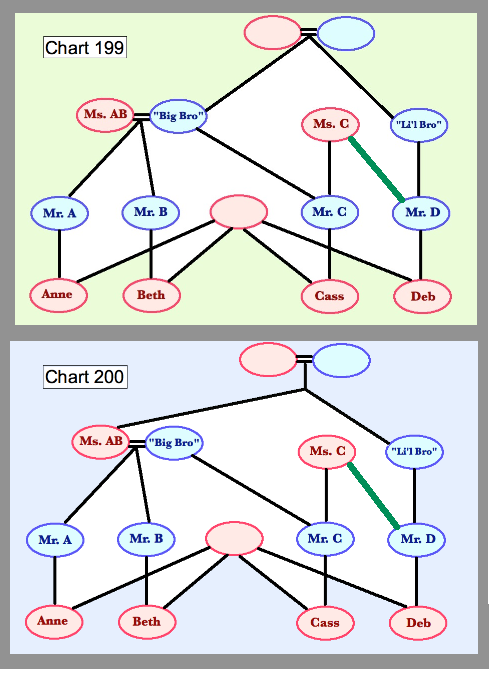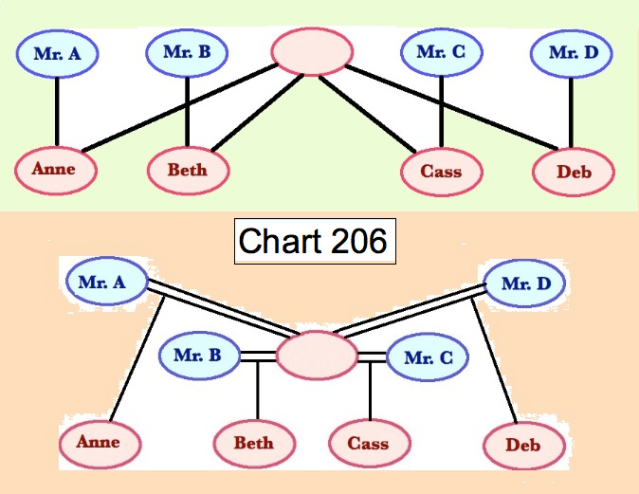Mail Delivered on Sunday…Wow!
61.1 Dear Friends: How did you make out with last week’s challenge? As shown below, we took the tree of the 4 half-sisters whose fathers were 2 brothers, their half-brother, and their 1st cousin..and asked how these half-sisterly relationships would be changed if Ms. C were in fact the mother of 2 of fathers instead of just one…as represented by the green line added between Ms. C and Mr. D.
61.2 Soooooo…since Ms. C isn’t related to either Anne or Beth, the change effects only Cass and Deb. They are still half-sisters (CR = 1/4) on their mothers’ side and still 2nd cousins (CR = 1/32) on their fathers’ side, since Mr. C and Mr. D are 1st cousins. But Cass and Deb are now doubly related on their fathers’ side, since Mr. C and Mr. D are now also half-siblings, so Cass and Deb are also half-1st cousins (CR = 1/16.) Total CR = 11/32, up from 9/32.
61.3 But recall, the question as stated allowed a second interpretation…that Mr. D was 1st cousin to Messrs. A & B not their their fathers…Big Bro and Li’l Bro…but thru Mr. D’s father Li’l Bro being a sibling of Messrs. A & B’s mother Ms. AB. Again, since Ms. C is unrelated to the “AB” side of the family, this change effects only Cass and Deb. They are still half-sisters on their mothers’ side (CR = 1/4)…but now, instead of having no relationship thru their fathers, they are half-1st cousins ( CR = 1/16) owing to their fathers being half-brothers thru Ms. C. Total CR = 5/16, up from 4/16 or 1/4.
Dear G4BB: Are all 1st cousins related to their own 1st cousins to the same degree? …from Pilar, in Paducah
61.4 Dear Pilar: A subtle yet interesting question. The mere fact that you asked it shows you have your doubts, and rightly so. The simple answer, by definition, is yes: all 1st cousins have a Coefficient of Relationship of 1/8…on average, they share 1/8th of their genes. Thus they are a quarter as closely related as full siblings, half as close as half-siblings. But in practice, a pair of 1st cousins may be related in other ways besides 1st cousins…say 1st cousins on their fathers’ side, 2nd cousins on their mothers’ side, so their CR is higher. This is what’s called “irregular double cousins.” If they were “regular double cousins,” they’d have the same relationship on both sides of the family…in the case of 1st cousins, if their fathers are brothers and their mothers are sisters, they are “double 1st cousins,” with a CR equivalent to half-siblings…1/8 + 1/8 = 1/4.
61.2 But what I suspect is eating at you is that the basic definition of 1st cousins is a little loose…2 people who have a common grandparent but not a common parent. By the letter of this definition, “half 1st cousins” would be considered “1st cousins,” as contrasted with “full 1st cousins.” And indeed, your full 1st cousin can be thought of as your half-1st cousin on both sides… 1/16 + 1/16 = 1/8…just as a full sibling can be considered a half-sibling on both sides…1/4 + 1/4 = ½.
61.3 Remember, full 1st cousins have parents who are full siblings…half-1st cousins have parents who are half-siblings…thus, thru that common parent, half-siblings will share only 1 grandparent, not the normal 2. It matters because half-cousins are only half as closely related as full cousins. The standard definition for “numbered” cousins…1st, 2nd, 3rd, etc…establishes how many generations back you need to count. But the key to full 1st cousins is their parents have the same parents…that is, the cousins have the same 2 grandparents on the side they’re related. Contrast this with double half-1st cousins, who also share 2 grandparents (A and B), but not thru the same parents, as shown in Chart 204. Double half-1st cousins are as closely related as full 1st cousins, but thru 2 different lines of descent, as you can see.
Dear G4BB: You have talked about 2 different kinds of kinship diagrams…what you call “family trees” with descending “branches,” what people would more or less view as traditional or standard. And what you call “parental trees” where the only connections are between parents and children…altho sometimes you mix (I’ll refrain from being trendy and using the word “hybridize”) the 2 kinds…true? …from Scotty in Scottsboro
61.4 Dear Scotty: True. Busted. Altho you must have gathered that the overriding consideration is to make the diagrams easy to follow and understand. But you’re also right to use the word “traditional”…when a man and a woman wed, had children, and the children wed and had their own children, the downward branching illustrated these relationships perfectly…hence even the use of the word “tree.” In such a traditional setup, single lines connecting 2 individuals indicate parent and child…double lines between 2 individuals indicate a marriage, or at least a biological union, altho in the old days that was presumed to be matrimony. Single lines connect those double lines to the offspring. Sometimes an “X” is used instead of the double lines, but the double lines come in handy if the 2 individuals are situated far apart on the diagram.
61.5 But you’re right about my mixing the 2 styles…and for an example of that, we need look no further than Chart 204 above. Look on the left side of Chart 205, the 1st cousins diagram. I have redrawn it below, sticking to the letter of the law, that is, every parent is connected to every offspring. More complicated than the original? Only slightly so…my original thought was to remove as much clutter as possible.
61.6 Similarly, on the right with double half-1st cousins, I originally connected A to his 2 sons with branching lines instead of straight ones…here it’s a matter of compactness. Otherwise, the bottom part of the diagram would have had to have been spread out so as to bring A’s position in closer. Really, it’s all a matter of style and personal preference…but again, with the goal of being as clear and concise as possible.
61.7 But what makes parental trees useful is the fact that there is only one kind of connecting line, that between parent and child. The 2 parents involved are not connected by a double line or in any other way. For example with Chart 199 from last week, how would you connect the common mother of the 4 half-sisters with the 4 fathers? It would be messy to say the least, as you can see in the lower diagram of Chart 206. The fact that Messrs. A, B, C, and D cannot be on the same horizontal line causes confusion…add to that, connecting the grandparents’ generation…Ms. AB, Big Bro, and Ms. C…to their sons would mean crossing double lines, making the whole thing a hopeless jumble…so much so that I don’t have the heart to do it…I can see it in my mind, and that’s enough…you can do it as an exercise, if you must.
◊◊◊◊◊◊◊◊◊◊◊◊◊◊◊◊◊◊◊◊◊◊◊◊◊◊◊◊◊◊◊◊◊◊◊◊◊◊◊◊◊◊◊
On a personal note…in terms of site views, last week marked the busiest week and the single busiest day since I started this blog in September of 2010. And March 2012 has been the busiest month ever, with 5 times as many hits as March 2011. And this despite the time constraints that have forced me to cut back to just once a week, the genealogy blog. Well, when I was unemployed (“pseudo-retired”), this WAS my job 😉 ;)…so a heartfelt thanks to you from this thick-fingered geezer…and see you next week with more familial entanglements!
________________________________________
Copyright © 2012 Mark John Astolfi, All Rights Reserved
shameless plugs…plenty to see here, folks!
Podcasts at http://stolfpod.podbean.com and http://thewholething.podbean.com
Other Blog at http://stolf.wordpress.com (the legendary Stolf’s Blog)
More bloggage at http://travelingcyst.blogspot.com
Updated Resume at http://travelingcyst.blogspot.com/p/resume.html
Audio samples at http://stolfspots.podbean.com





I’m not positive the place you are getting your information, however great topic. I must spend a while finding out more or working out more. Thank you for wonderful info I used to be looking for this info for my mission.